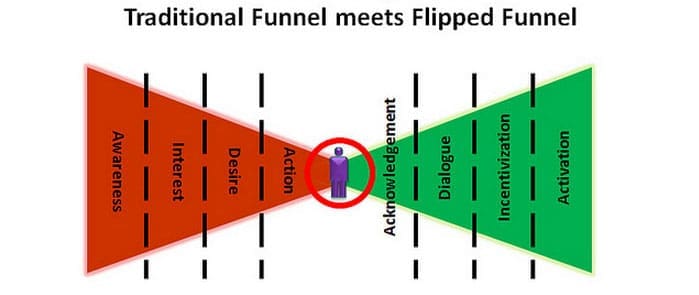All too often in conversations with clients and colleagues, I hear the terms “Lead Generation” and “Demand Generation” used interchangeably.
Of course, once you start asking more questions, it becomes rather easy to delineate between which of the two they are really talking about.
But the issue remains that too few of us understand the differences between the two terms.
So today I am sharing my take on what they mean.
What is Demand Generation?
Demand Generation is about creating demand.
How is that done? Pretty simply, by building awareness, creating a buzz, and generally raising your public profile. It is about positioning yourself to drive business.
This includes branding, advertising, reputation management, public relations, and everything else that proves you are a credible vendor that can fill a real need in the market.
As such, demand generation is not truly under your control. Sure, you can exert a tremendous amount of influence over demand.
In fact, although it spans across all lifecycle stages, Search Engine Optimization can have a major impact on your demand generation success.
With deep enough pockets, you can cast a wide net, which will surely catch a few prospects.
But there’s no concrete, “do this and you definitely get that” formula for Demand Gen.
It is more of an art than a science, because you are working with “this will probably happen” types of scenarios.
You do the right things and they typically work, though not always.
Now let’s look at something you have more control over: Lead Generation.
What is Lead Generation?
Lead Generation capitalizes on Demand Generation successes.
Once the demand is there, the onus is on you as the vendor to identify prospects, engage them, and close a sale.
Basically, lead generation is about capturing leads, working them, and generating revenue.
There are many ways to manage lead generation.
From CPC-based advertising to working an email list over time, lead generation is about finding the “needle in the haystack” of leads.
There is a whole list of data-driven tactics in the lead generation toolbox, including conversion rates, lead nurturing / drip marketing, sales automation, and lead scoring.
Managing these tactics can quickly become overwhelming, so it’s worth your time to consider automating most of the process.
How Lead Generation and Demand Generation Complement Each Other
Demand Generation and Lead Generation affect two very distinct pieces of the customer lifecycle or sales funnel.
These concepts describe the process a customer goes through from the first time they hear about a brand until they actually buy something.
A typical lifecycle model based on the customer perspective might have stages such as awareness, familiarity, consideration, and finally, purchase.
These stages are based on the psychology or perspective that a typical prospect goes through along the path to purchase.
A sales funnel, on the other hand, labels prospects based on likelihood to purchase.
Typical stages in a sales funnel will be lead (suspect), prospect, qualified prospect, committed prospect, and finally, purchasing customer.
While this is good for internal forecasting, it is not an effective vehicle for messaging or customer-centric marketing and selling.
In a well-structured sales and marketing strategy, Demand Generation plants the seeds of the fruit trees.
Lead generation then swoops in and picks the fruit when they are ready to eat.
Demand Generation has evolved over the past several years.
While we once did push marketing to drive awareness and credibility, social media has opened a bidirectional path of communication with prospects and customers.
Your ability to generate demand is now dependent on how you engage, in addition to how you position and brand the company.
Your ability to retain demand (i.e. retain faithful customers) is also dependent on how well you handle the conversation with paying customers.
This is why social media is inherently a poor way to generate leads.
It’s also why very few of us have figured out how to measure a true ROI for it.
Investing in social media is not and has never been a “free” way to generate more leads.
- Measure it based on awareness and credibility.
- Measure it based on impact on the conversation.
- Even measure it as a piece of your overall customer satisfaction and retention analysis.
As for Lead Generation, you should aim to measure it by how successfully you are able to:
- Identify interested prospects
- Capture their information as leads
- Move them along the rest of the sales funnel toward a purchase
Metrics of interest here would include conversion rate, return on ad spend (for CPC based advertising), standard email marketing metrics, lead scoring, and win/loss rates for the sales team.
As you can see, Demand Generation feeds Lead Generation. It also influences Lead Generation.
But the reality is that the two are very complementary.
They help you manage two very distinct pieces of your sales and marketing process. And you need both of them.
Summary
Lead Generation and Demand Generation are two very different concepts.
They both serve a purpose, so use them in tandem in your own business.
And the next time you hear some know-it-all bandying the terms about as though they are one concept, help them understand how they differ.
If we want to succeed as marketing and sales professionals, we all need to speak the same language.
New Sales Funnel Feature Image Derived from “The New Integration” by Joseph Jaffe, as shared on Flickr.
Tommy Landry
Latest posts by Tommy Landry (see all)
- The Complete Guide to Dental SEO: How Dentists Can Attract More Local Patients Online - November 25, 2025
- How AI Is Changing eCommerce SEO and Product Discoverability - November 20, 2025
- Social Signals and SEO: Why Engagement Still Matters in the AI Era - November 18, 2025





